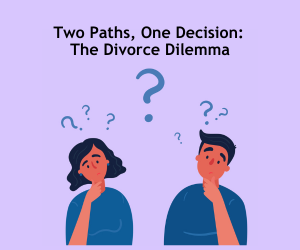 Our last blog post from Daisy Camp discussed ways you can avoid going to trial in a divorce. The last thing anyone wants is to go to trial, but sometimes going to trial is simply unavoidable. The good thing is, less than 5 percent of divorce cases go to trial, but what if you find yourself amongst that 5 percent? What can you expect in a divorce trial?
Judges generally try to help you resolve your case before the trial date, but sometimes that is simply impossible. If, after months, and sometimes even years of negotiations, you and your soon-to-be-ex-spouse still have not reached an agreement, your last recourse is to have a trial. Divorce trials typically do not involve juries, but are held by a judge in the judge’s chamber. The judge reviews volumes of documents, hears evidence from each spouse, your respective divorce attorneys, possibly witnesses, and then come to a decision based on evidence.
Trials can be as short as half a day or as long as several months (although that would probably be unusual for a divorce trial). The length of a trial depends on the number of witnesses, how long each examination takes, and what motions are made during the course of the trial. The emotional and financial costs rapidly add up. Divorces can be very expensive, but divorces that go to trial are even more costly, both financially as well as emotionally.
According to the book “The Collaborative Way to Divorce” by Collaborative Attorneys, Stuart Wells & Ron Ousky, “When divorcing the “traditional way” settlement may only happen only after you or your spouse have been to court on one or more occasion, for temporary hearings, settlement conferences, and so on. Sometimes these cases settle within days or hours before the trial is scheduled to begin – after you and your spouse have already incurred most of the financial and emotional cost of preparing for trial.” In these cases although the trial was avoided, the damage is already done.
Our last blog post from Daisy Camp discussed ways you can avoid going to trial in a divorce. The last thing anyone wants is to go to trial, but sometimes going to trial is simply unavoidable. The good thing is, less than 5 percent of divorce cases go to trial, but what if you find yourself amongst that 5 percent? What can you expect in a divorce trial?
Judges generally try to help you resolve your case before the trial date, but sometimes that is simply impossible. If, after months, and sometimes even years of negotiations, you and your soon-to-be-ex-spouse still have not reached an agreement, your last recourse is to have a trial. Divorce trials typically do not involve juries, but are held by a judge in the judge’s chamber. The judge reviews volumes of documents, hears evidence from each spouse, your respective divorce attorneys, possibly witnesses, and then come to a decision based on evidence.
Trials can be as short as half a day or as long as several months (although that would probably be unusual for a divorce trial). The length of a trial depends on the number of witnesses, how long each examination takes, and what motions are made during the course of the trial. The emotional and financial costs rapidly add up. Divorces can be very expensive, but divorces that go to trial are even more costly, both financially as well as emotionally.
According to the book “The Collaborative Way to Divorce” by Collaborative Attorneys, Stuart Wells & Ron Ousky, “When divorcing the “traditional way” settlement may only happen only after you or your spouse have been to court on one or more occasion, for temporary hearings, settlement conferences, and so on. Sometimes these cases settle within days or hours before the trial is scheduled to begin – after you and your spouse have already incurred most of the financial and emotional cost of preparing for trial.” In these cases although the trial was avoided, the damage is already done.
Two Paths, One Decision: The Divorce Dilemma
Emily and Daniel were in love. Their love story had once been the envy of the neighborhood—a whirlwind romance that blossomed into a marriage filled with laughter, shared dreams, and whispered secrets. But as the years went by, cracks appeared in their fairy tale....



